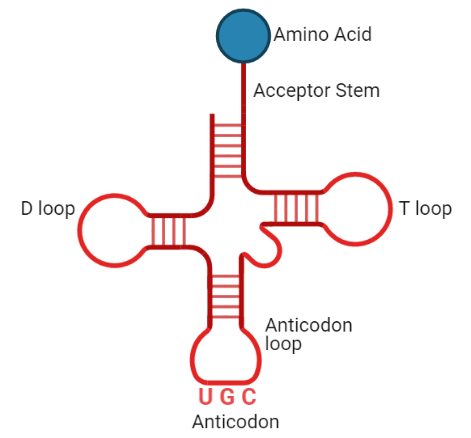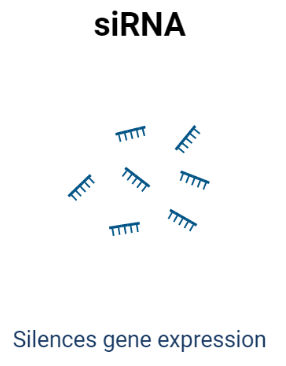What is RNA?
RNA stands for ribonucleic acid. It is a polymer of ribonucleotides. In comparison to DNA, RNA is a single-stranded molecule and consists of much shorter strands of nucleotides.
Ribonucleotide is made up of ribose sugar, a nitrogenous base (purine or pyrimidine), and a phosphate group.
Ribose sugar is a pentose sugar that exists in cyclic form. RNA is susceptible to hydrolysis due to the presence of a chemically reactive hydroxyl (-OH) group present at the second carbon group in the ribose sugar molecule.
Nitrogenous bases in RNA are Adenine, Guanine, Thymine, and Uracil. The Thymine base in DNA is replaced with a Uracil base in the case of RNA. Adenine and Guanine are purine, containing a two-ring structure, while Uracil and Thymine are pyrimidines having a single ring structure. The nitrogenous base is attached to 1st carbon of ribose sugar in the ribonucleotide molecule.
The phosphate group consist of 1 phosphorous and 4 oxygen atoms, thus having a chemical formula of PO43-. The phosphate group is attached to the 5th carbon of ribose sugar in the ribonucleotide molecule.
Two or more ribonucleotides are joined with each other to form long-chain molecules with the help of phosphodiester linkage. Phosphodiester linkage is an ester bond formed between the –OH group of the 3rd carbon of ribose sugar and the phosphate group of the 5th carbon.
Types of RNA and Its Function
There are two types of RNA present in a prokaryotic and eukaryotic cell.
- Major types of RNA
- Minor types of RNA
1. Major types of RNA
The three major types of RNA are involved in the synthesis of protein. They are extensively studied and present in all organisms. Their proper functioning is key to healthy and functional cells and organisms. The three major types of RNA are:
- Messenger RNA (mRNA)
- Transfer RNA (tRNA)
- Ribosomal RNA (rRNA)
1. Messenger RNA (mRNA)
Messenger RNA or mRNA is a single-stranded molecule that is complementary to the gene sequence of DNA. It is synthesized from the DNA by the process of transcription.
The mRNA formed is further modified by splicing, capping, and the addition of poly-A tail to make it mature mRNA before exiting the nucleus. The modification is important to protect the mRNA from enzymatic degradation and correct the synthesis of the protein molecule. In a cell, the amount of mRNA is about 3-4% of the total RNA.
The length of RNA is variable and depends on the length of the protein. So larger the protein, the longer the mRNA. For example, to make a protein of 500 amino acids, mRNA of 1500 (3 x 500) nucleotide will be transcribed.

|
| Structure of mRNA. Image created in BioRender.com |
Function of mRNA
It carries the genetic message from the nucleus to the ribosomes present in the cytoplasm of a cell where amino acids are arranged according to the information in mRNA to form a specific protein molecule.
2. Transfer RNA (tRNA)
Transfer RNA or tRNA is a small adaptor molecule having a chain length of about 75-90 nucleotides and serves as the link between mRNA and amino acids of the growing protein chain. It comprises about 10-20% of the cellular RNA.
The tRNA is a single-stranded molecule that is folded to form three hairpin loops due to complementary pairing. One hairpin loop has 3 codon sequences complementary to mRNA called an anticodon. The anticodon helps in the recognition and accurate binding of tRNA to the mRNA and helps in the synthesis of protein.
An amino acid is attached to the other end of the tRNA that matches the sequence of the anticodon. Each tRNA carries a specific amino acid, so there are many types of tRNA. Moreover, as one amino acid can be encoded by different codons, so the tRNA having different anticodons carry the same amino acids.

|
| Structure of tRNA. Image created in BioRender.com |
Function of tRNA
The tRNA as the name indicated transfers the amino acid molecules to the site where peptide chains are being synthesized. The tRNA attaches to the mRNA by the matching of anticodon and amino acid is delivered to growing polypeptide chain by the forming peptide bond.
3. Ribosomal RNA (rRNA)
Ribosomal RNA or rRNA is strongly associated with ribosomes. The ribosome is made up of 40% ribosomal protein and 60% rRNA. Ribosomal DNA transcribes rRNA, which then attaches to the ribosomal proteins to form small and large ribosomal subunits. A major portion of RNA in the cell is made up of rRNA i.e., up to 80% of the total RNA.
Prokaryotic ribosomes contain three types of rRNA. The small subunit contains 16S rRNA (S=Svedberg unit), while the large subunit contains 23S and 5S rRNA. These rRNA combines with ribosomal protein and form 30S small subunit and 50S large subunit, which collectively form 70S prokaryotic ribosome.Eukaryotic ribosome is made up of 40S small subunit and 60S large subunit. The small subunit contains 18S rRNA and the large subunit contains 5S, 5.8S, and 28S rRNA.

|
| Structure of rRNA. Image created in BioRender.com |
Note: The S subunits of the rRNA cannot merely be added because they show the sedimentation rate rather than of mass.
Function of rRNA
The rRNA acts as a machinery for the synthesis of proteins. It aids in the binding of mRNA and tRNA during the process of translation. The tRNA is sandwiched between small and large ribosomal subunits.
During translation, the tRNA interacts with mRNA with the help of anticodon in the small subunit of the ribosome, while amino acid carrying part of tRNA interacts with rRNA in the large subunit. The transfer of amino acids from tRNA to the growing chain with the help of peptidyl transferase is initiated by rRNA.
Video Lesson
2. Minor types of RNA
They are also known as small RNA as they have less than 200 nucleotides. These types of RNA are non-coding and not involved in protein synthesis but take part in the regulation of gene, post-transcriptional modification, catalytic function, and DNA replication. Some important minor types of RNA are:
- Small nuclear RNA (snRNA)
- Micro RNA (miRNA)
- Small interfering RNA (siRNA)
1. Small nuclear RNA (snRNA)
Small nuclear RNA or snRNA are non-coding RNAs that are found in the nucleus of a eukaryotic cell. They are not found in prokaryotes. The average length of snRNA is about 50 nucleotides. The snRNA is bound with proteins to form a complex called ribonucleoprotein particles that aid in the splicing process.

|
| Structure of snRNA. Image created in BioRender.com |
Function of snRNA
They are involved in the splicing of intron and processing of pre-mRNA in the nucleus. Moreover, they are also known to be involved in the regulation of gene expression.
2. Micro RNA (miRNA)
Micro RNA or miRNA are non-coding, single-stranded and about 22 nucleotides long. They are found in animals and plants and absent in prokaryotic cells.

|
| Structure of miRNA. Image created in BioRender.com |
Function of miRNA
They perform the function in RNA silencing by degradation mRNA molecules, destabilizing it by chopping poly-A tail or reducing translation of mRNA into protein. In mammalian cells, miRNA are released into body fluids and serve as biomarkers in several diseases.
3. Small interfering RNA (siRNA)
Small interfering RNA or siRNA are non-coding, double-stranded RNA with a length of about 20-24 base pairs.

|
| Structure of siRNA. Image created in BioRender.com |
Function of siRNA
They control the expression of specific genes by destroying mRNA and inhibiting its translation.
Some Questions and Answers
1. Which sugar is present in RNA?
A. Ribose sugar is present in RNA.
2. How RNA is different from DNA?
A. RNA is a single-stranded molecule, while DNA is double-stranded. RNA has ribose sugar and uracil nitrogenous base, while DNA has deoxyribose sugar and Thymine nitrogenous base.
3. Which type of RNA is involved in protein synthesis?
A. Three RNAs including mRNA, tRNA, and rRNA are involved in protein synthesis.
4. What is the function of mRNA?
A. The mRNA carries the genetic message from the nucleus to the ribosomes present in the cytoplasm of a cell where amino acids are arranged according to the information in mRNA to form a specific protein molecule.
5. Explain how tRNA is bound with mRNA?
A. The tRNA attaches to the mRNA by the matching of anticodon and amino acid is delivered to growing polypeptide chain by the forming peptide bond.
6. What are the examples of non-coding RNA?
A. small nuclear RNA (snRNA), micro RNA (miRNA), and small interfering RNA (siRNA) are non-coding RNA and are not involved in protein synthesis.





0 Comments